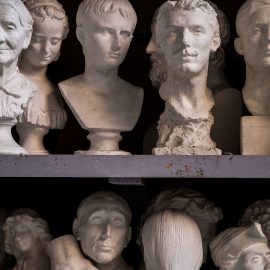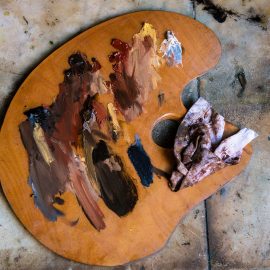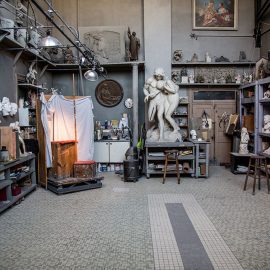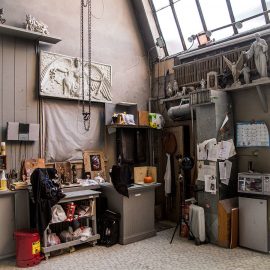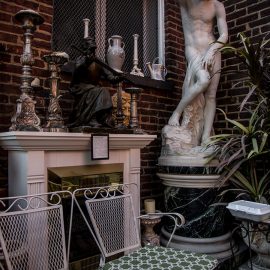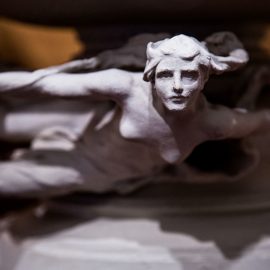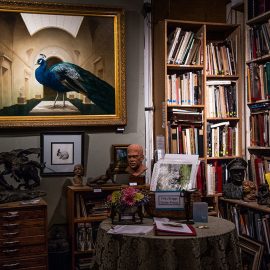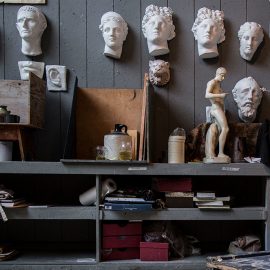News & Community
You Are Here: December 2016
First-hand accounts from the Schuler School of Fine Arts, a 70-mile run, and Doors Open Baltimore.
Time Out of Mind
East Lafayette Avenue
October 22, 2016
The metal letters nailed on the wooden door read simply: “HANS SCHULER—SCULPTOR.” “I’ve walked past it so many times and have always been curious about what’s inside,” says a visitor, ducking into the 110-year-old ivy-covered brick and sky-lit atelier.
“We get that a lot,” chuckles Francesca Schuler Guerin, the granddaughter of Hans Schuler, an Alsace-Lorraine immigrant known as Baltimore’s “monument maker” for his classical works across the city. An accomplished sculptor in her own right, Guerin is leading a rare tour of the Schuler School of Fine Arts, founded here in 1959 by her parents—Schuler’s son, also named Hans, and her mother, Ann Didusch Schuler.
Schuler’s works include five pieces in the Walters Art Museum collection, most notably a sculpture of Ariadne, the distraught daughter of the mythological Greek king Minos, which won him a gold medal at the Paris Salon in 1901. His outdoor works include the renowned Meditation and Memory pieces at Green Mount Cemetery, the 18-foot statue of Martin Luther at Lake Montebello, and the giant relief of Gen. Casimir Pulaski at the entrance to Patterson Park.
At the moment, a half-dozen students—surrounded by original scale models of Schuler’s sculptures—are quietly painting and sculpting clay in the day-lit studio, as others practice the basic drawing techniques that serve as the foundation of the school’s traditional curriculum. Students here learn to grind their own pigments in the manner of the old masters. In fact, the school was started as a protest against the modernist movement sweeping the nearby Maryland Institute College of Art, where Hans and Ann taught and the elder Schuler served as director from 1925-1951.
Despite the changing times, the school survives, buoyed by a commitment to what Schuler once described as “pure art” that has remained steadfast through succeeding generations. “I read an art magazine story about how the practice of teaching ‘cast’ drawing [charcoal studies of plaster busts] has been recently ‘rediscovered,’” Guerin says. “We’ve always taught cast drawing. It’s not like somebody’s discovered the Incas or something.”
Homeward Bound
Greenmount Avenue
October 10, 2016
“I counted on the first 60 miles wearing her down, but it didn’t help,” laughs Erek Barron, a Prince George’s County state delegate, as he jogs into the Greenmount Avenue offices of Community Mediation Maryland behind a surprisingly fresh Lorig Charkoudian. “She can run.”
Charkoudian, co-founder of the nonprofit, which offers free mediation services to prison inmates, their families, and others, had just completed a two-day, 70-mile run from Hagerstown to Baltimore to raise awareness about the benefits of reentry services. She was joined by supporters along her trek—symbolic of the journey thousands make each year as they return from Hagerstown’s penitentiaries—and by Barron, a key legislator behind Maryland’s recent Justice Reinvestment Act, who ran the final 10 miles with her.
Charkoudian picked up a gaggle of runners as she reached the Baltimore Museum of Art and then was greeted by balloons and cheers as she led the way across 33rd Street. Later, glancing at a 10-foot map hung in the nonprofit’s hallway to chart her progress, she notes her southeastern route appears misleading. “It looks downhill, but I can assure you it wasn’t,” she says, running her finger toward the Appalachian Mountains.
Among those meeting Charkoudian were Barbara Doran and her daughter, Rita, who went through multiple family mediation sessions with Doran’s son, Ricky, who has been incarcerated for much of the past 13 years. “I didn’t know what we were going to do with him when he got out,” says Barbara, choking up. “We had lost trust.” Rita, 22, adds she grew up without her brother around. “Basically, we didn’t have a relationship.”
“The sessions were his idea. He learned about them [while incarcerated],” Barbara says. “They’ve made a big impact on all our lives. And my son isn’t even home yet.”
Visiting Hours
St. Paul Street
October 22, 2016
Charlie Murphy taps the brakes of his road bike as he heads down St. Paul Street, slowing to allow the three-dozen bicyclists trailing behind to keep pace during the blustery morning start of the Doors Open Baltimore Bike Tour. With more than 50 distinctive buildings accessible to the public today, the third annual Doors Open project—organized by the Baltimore Architecture Foundation and the Baltimore branch of the American Institute of Architects—offers a free opportunity to peak inside some of the most historic sites in the city.
Led by Murphy, a Bikemore board member, and Zach Chissel, founder of Two Wheel Tuesday—a weekly bike-to-work event—the ride includes stops such as the Arabber Preservation Society in Sandtown, the new Lillie Carroll Jackson Civil Rights Museum in Bolton Hill, the Eubie Blake Cultural Center on Howard Street, Open Works in Greenmount West, and Lovely Lane United Methodist Church on St. Paul Street, before wrapping up at the Peabody Heights Brewery situated at the former home of old Oriole Park in Waverly.
The oldest building on the cue sheet is the first—the Lovely Lane church, which broke ground in the late 1800s, almost a century after its original meeting house hosted the famous Christmas Conference that established the first Methodist denomination in the U.S. Designed with an oval sanctuary for better acoustics, the church still has its original organ and oak seats. But it is best known for its nearly 200-foot tower—with massive windows that are lit in the shape of a cross each evening—and in the dome above the pulpit, a heavenly fresco depicting the stars in their exact position on the night of the church’s dedication on Nov. 6, 1887.
“It’s a great place to preach, but if you’re boring, you’ll know right away,” says the Rev. Travis Knoll. “Everybody starts looking up.”
